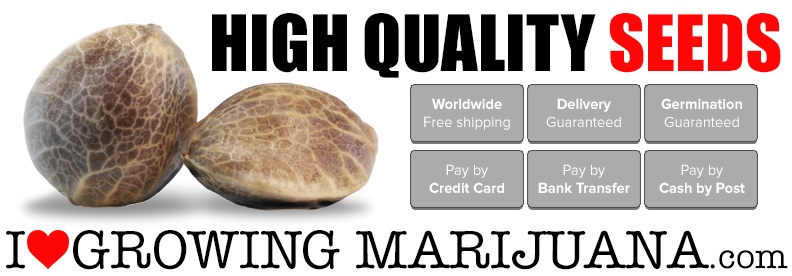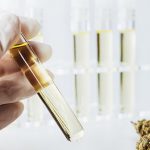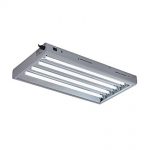Cannabis plants need nutrients for their proper development and high quality yields. The three main nutrients plants need most are nitrogen, potassium, and phosphorous. Besides these three micronutrients, marijuana plants need other nutrients that help them to thrive. The other nutrients include magnesium, calcium, copper, iron, manganese, boron, silicon, zinc, sulfur, and boron.
Among the secondary nutrients, the most crucial for the plant’s development and growth after the three primary nutrients is magnesium. Without magnesium, plants may not thrive well, as they can wither before eventually dying. How do you spot magnesium deficiency in cannabis plants, and how do you treat it? Read on for more information on the topic.
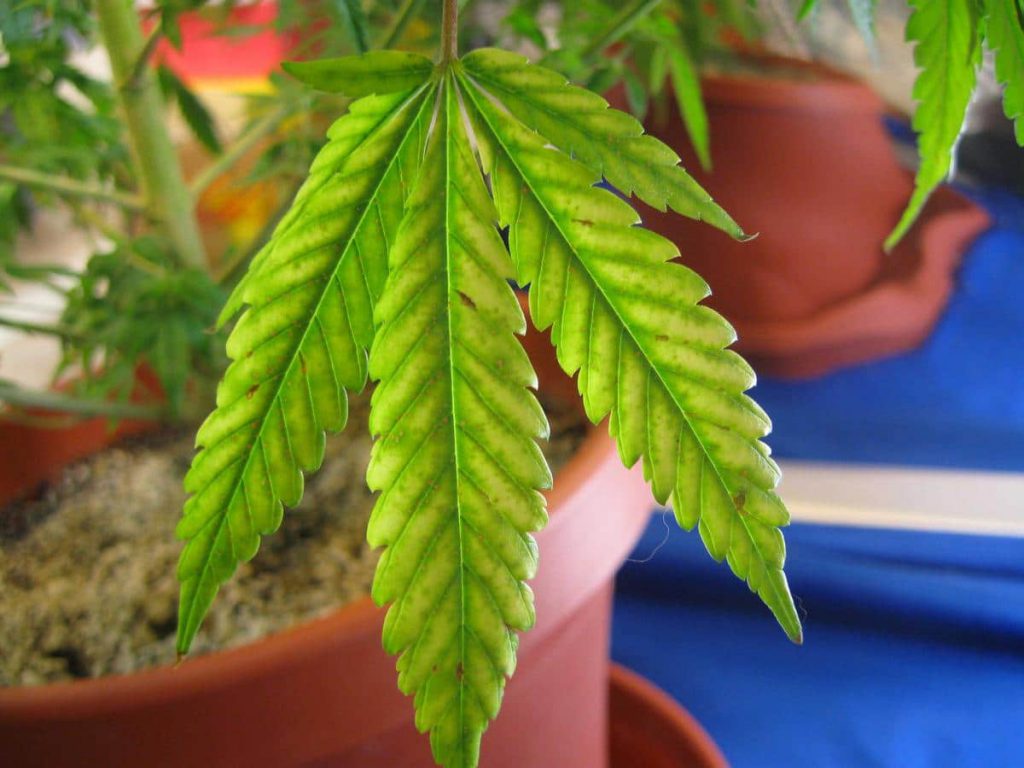
Read next: Cannabis Light Burn – How To Detect And Treat
Why Cannabis Plants Need Magnesium
Magnesium is essential for cannabis and every other plant to grow strong and healthy stimulus and veins on the development of cannabis leaves. The nutrient also plays a huge role in breaking down enzymes, producing chlorophyll, and photosynthesis. Magnesium deficiency mostly affects indoor plants more than it does outdoor plants.
The plants mostly affected are those growing in hydroponic systems and other indoor growing mediums. Failure to deal with magnesium deficiency fast enough leads to losing the lower older cannabis plant leaves that first die before falling off. Once magnesium deficiency hits the plants, even providing enough light does not restore them to normal growth.
[amazon bestseller=”cannabis nutrient”]How to Spot Magnesium Deficiency in Cannabis Plants
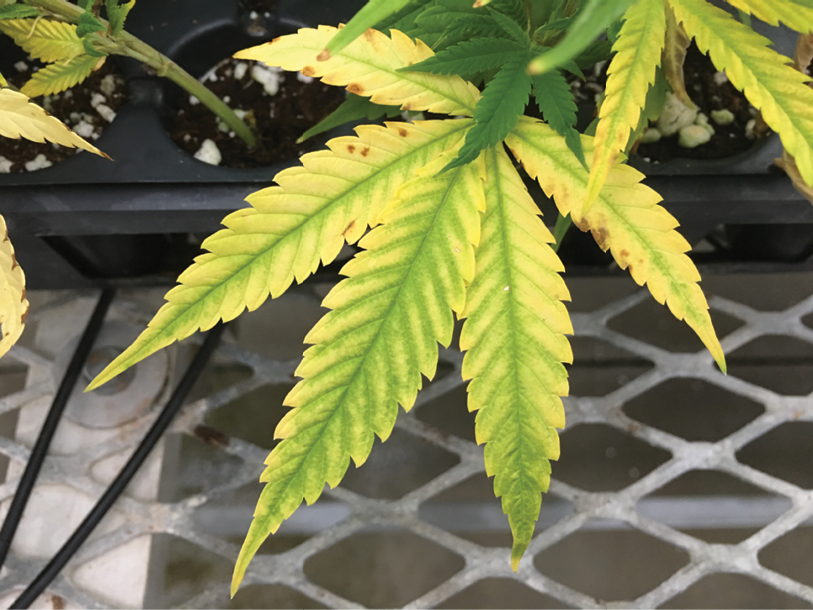
In summary, the following are the signs of magnesium deficiency in cannabis plants.
- Yellowing of the lower leaves that starts at the outer edges and moves inwards, forming a tie-dye appearance,
- Full leaves start turning yellow if not checked in time with green color along the leaf veins.
- Edges turn yellow while leaves turn brown before dying.
- Stems change their color to red
Magnesium is the plant’s chlorophyll building block, which provides crops with a green color. Therefore, it is not surprising that the first signs of magnesium deficiency are chlorosis and yellowing of the leaves. Besides the color changes and chlorosis, the outline of the leaves become brittle and dry.
The symptoms show up first between the leaves’ veins and edges before moving to the middle and upper parts of the leaves. Besides the leaves, the stem also turns purple and sometimes red. As the essential “building block” of chlorophyll, magnesium provides the cannabis plant a solid, brilliant green color.
The first and least demanding way to distinguish the deficit of magnesium in cannabis plants is the leaves demonstrating a stressing blur of green to light green to yellow. In more extreme cases, the leaves also exhibit brown spotting, which is also a sign of another deficiency affecting the plant alongside magnesium deficiency.
The deficiency attacks leave closest to the bottom of the cannabis plant and older leaves first before moving to the newer leaves before moving to the newer ones. Affecting the older leaves first is the plant’s way of saving the newer leaves by withdrawing magnesium from the older ones.
Magnesium Deficiency in Cannabis Plants Dangers
Besides being an essential component for photosynthesis and the formation of chlorophyll in cannabis plants, magnesium is also crucial for the proper absorption of two micronutrients, phosphorous and nitrogen.
Lack of magnesium deficiency also causes poor development of flowers and the plant’s root system, which greatly affects the harvest. Many plants with magnesium deficiency rarely make it to the flowering phase because of the nutrient depletion, leaves turning color, falling, and eventually dying.
Causes of Magnesium Deficiency in Cannabis Plants
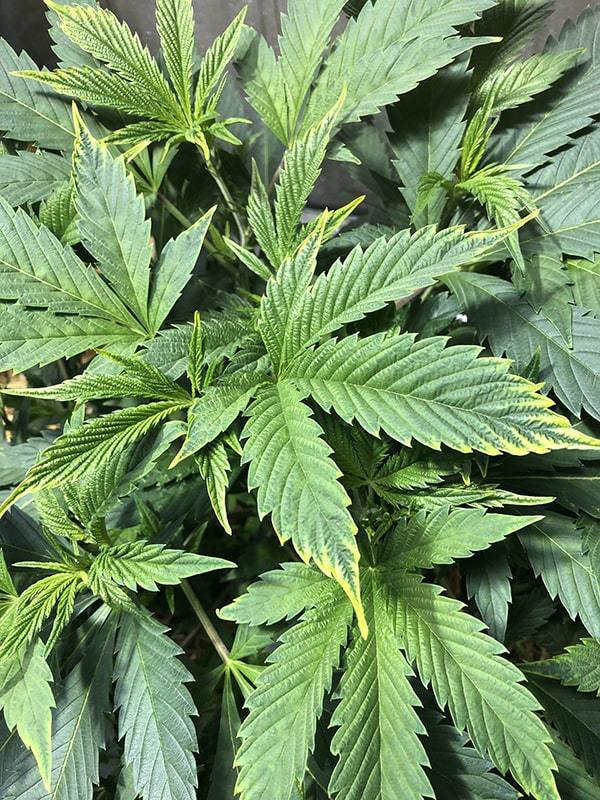
The first cause of magnesium deficiency in cannabis plants is the lack of it in the soil. Overwatering or flushing depletes magnesium from the soil, causing a deficiency. However, tap water comes in handy in some areas as it contains ample amounts of magnesium.
In some situations, the soil may contain sufficient magnesium levels, but plants fail to use the nutrients adequately. The reason for this is the low and acidic pH in the soil that prevents cannabis plant roots from proper absorption of magnesium irrespective of the levels.
Some growers make the mistake of adding more magnesium nutrients to an already overburdened substrate making the situation worse than it was. The excess magnesium locks out other essential nutrients leading to more than one nutrient deficiency to deal with.
How to Correct Magnesium Deficiency
It is not easy to test magnesium levels without using lab analysis. Unfortunately, very few cannabis growers have access to laboratory testing facilities for nutrient deficiency. Even without the laboratory analysis, there are several other ways growers use to correct magnesium deficiency.
-
Flushing
Flushing is the most way of correcting magnesium deficiency. The method involves flushing the nutrient build-up in a hydroponic or non-soil substrate with water containing the right pH balance. The water should also contain essential nutrients, including magnesium. Flushing helps to remove damaging nutrient salts that prevent the absorption of magnesium.
For the proper magnesium intake in hydroponic systems, the pH levels should be between 6.0 and 6.5. the nutrient ratio that the pH balanced water should contain depends on the stage of growth-vegetative or flowering in the case of the cannabis plant. When considering the nutrients to include in the mix, calcium should be present as its deficiency goes hand in hand with magnesium deficiency.
Magnesium deficiency is less severe in open ground soil than it is in pots. However, this does not mean that growing the plants in soil guarantees complete immunity from the deficiency. The pH of soil is best at between 6.0 and 7.0. using the same flushing method and adding calcium and magnesium supplements also work well in soil situations with the hydroponic systems.
[amazon bestseller=”ph soil tester”]-
Using Epsom salts
Using Epsom salts is also another way of fixing the magnesium deficiency in cannabis plants. The remedy involves mixing the salt with water and magnesium sulfate and spraying on the plants every three days.
Clean water spray is also part of the treatment plan. The water helps to eliminate the build-up of residue on the cannabis plants. besides Epsom salts and magnesium sulfate, other products you can use to enhance the quality of your cannabis yields and provide the plants with a proper nutrient balance are-
- Bergman’s Plant Booster
- Dolomite Lime
- Garden Lime
- Worm Castings
How Long It Takes the Plants to Look Better
It is not a guarantee that after taking care of the magnesium deficiency, the cannabis plants will bounce back to being 100% healthy. Some of the leaves will regain their normal green color while others will not recover at all.
The most important change that you will notice is the withering and discoloration will stop spreading. One or two leaves at the bottom may still exhibit signs of magnesium deficiency, but the rest of the cannabis plant will look healthy.
Read next: Cannabis Seedling Problems
How to Prevent Magnesium Deficiency
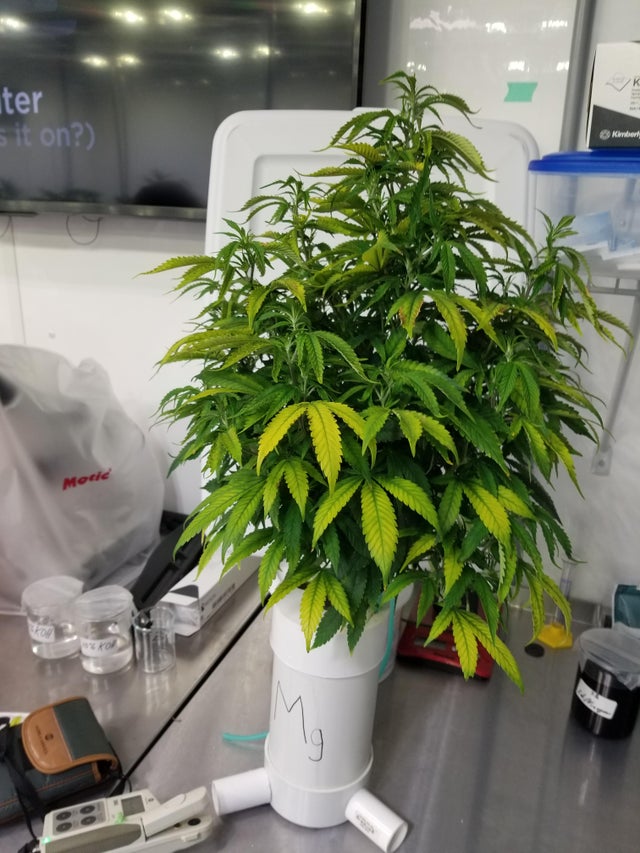
Preventing magnesium deficiency in your cannabis plants is possible. One thing to do is to pay close attention to cannabis plant growth and development. Monitoring each step of the growth process and any changes is also of paramount importance. When monitoring, ensure that you inspect the stems, stalks, and leaves of the plants at least once each day.
If you notice anything that is out of the ordinary, carry out some research or ask a cannabis grower who knows their way around the plants more for advice on fixing the problem before it gets out of hand. You can also prevent magnesium deficiency by growing your weed in a growing medium that comes with quality and ease of maintenance.
It would be best if you also buy strains that are healthy and have good genes. The best places to find the best strains are online seed banks or reliable breeders. You can find good planting medium and seeds from your local cannabis dispensary budtenders.
Cal-Mag (Calcium-Magnesium Deficiency)
Many cannabis growers believe that both magnesium and calcium deficiencies go hand in hand, leading to the treatment of both at the same time. The deficiencies also go by the name cal-mag deficiency, and the treatment is Cal-Mag.
However, the method of treating both deficiencies at the same time does not happen with all the growers as controversy surrounds the belief and use of Cal-Mag. The difference between the two is that magnesium deficiency affects the leaves on the lower part of the plant, which also happens to be the oldest.
On the other hand, calcium deficiency attacks the newer leaves on the higher part of the cannabis plant. Growers should keep close tabs on the plants to distinguish between the two deficiencies and come up with the best ways to treat them.
Wrapping It Up
Without the necessary nutrients, the cannabis plant would not thrive or have proper development. Magnesium is a vital nutrient for the crops as it helps with the crops’ photosynthesis and chlorophyll formation that gives the plants the green color.
A deficiency of the same leads to the leaves, stems, and stalks changing their appearances and color. Detected early, it is possible to fix magnesium deficiency and have the crops back to their initial appearance before the attack. We hope that the above guide helps you in keeping magnesium deficiency at bay or fixing the problem if the attack happens.
[amazon bestseller=”grow tent kit”]

